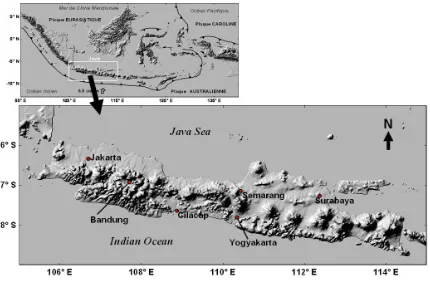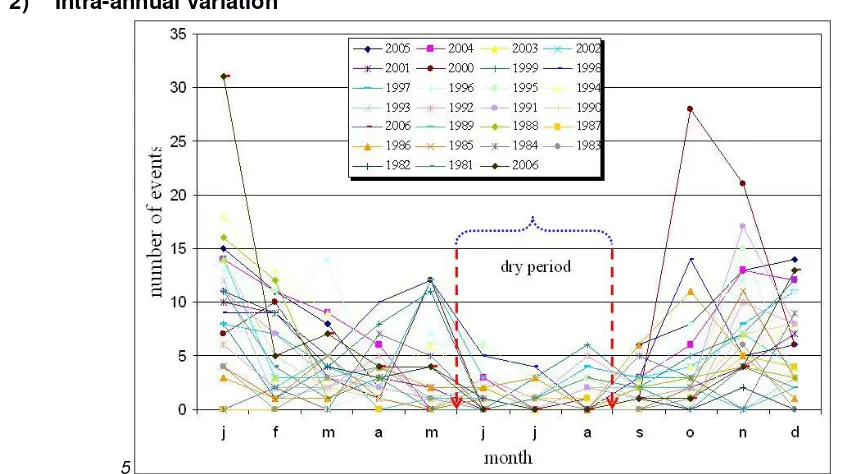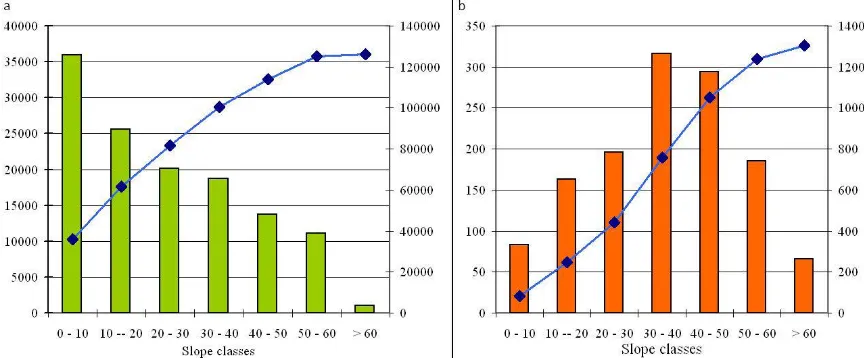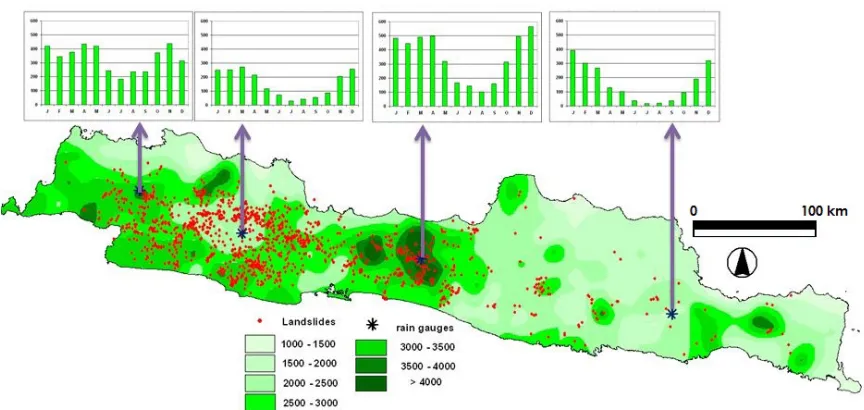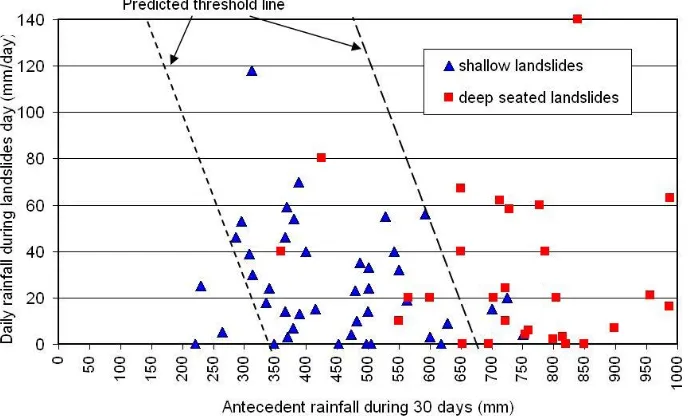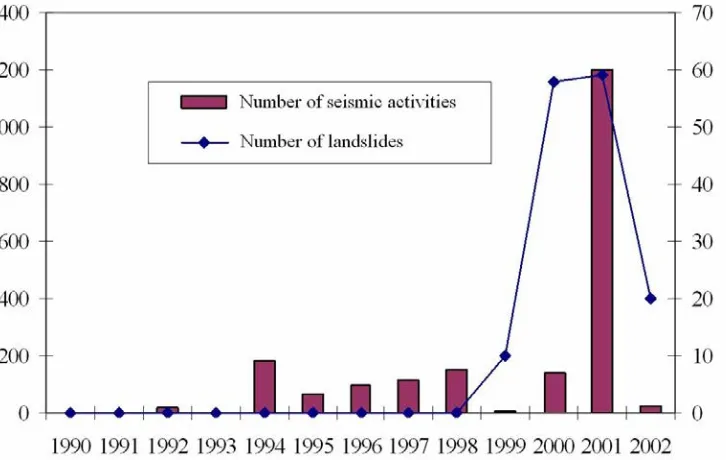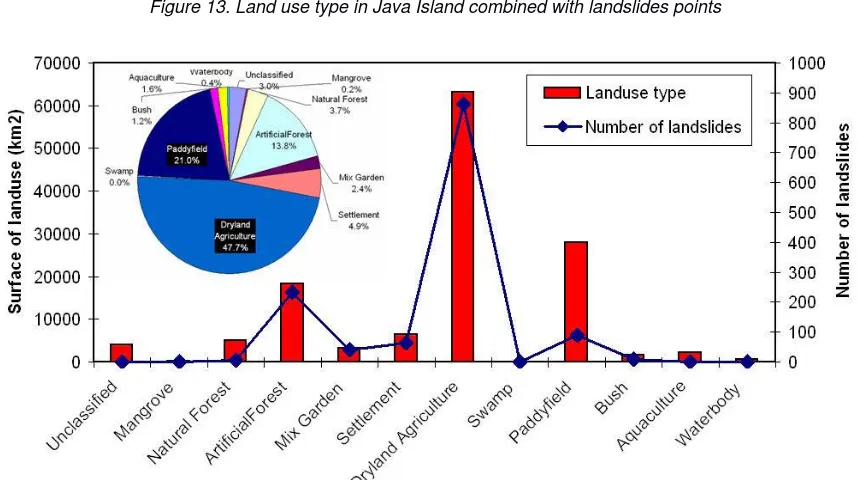© Author(s) 2017. CC BY-NC-ND Attribution 4.0 License.
Spatio-Temporal Distribution of Landslides in Java and The
Trigerring Factors
Danang Sri Hadmoko*,1,2, Franck Lavigne2, Junun Sartohadi1, Christopher Gomez3,4, Daryono5
1 Faculty of Geography, Universitas Gadjah Mada, Yogyakarta, Indonesia
2 Université Paris 1 Panthéon-Sorbonne & Laboratoire de Géographie Physique, UMR 8591 CNRS, Meudon, France 3 UCR3 - Risk, Resilience & Renewal, Waterways: Centre for Freshwater Management, College of Science, Department of
Geography, University of Canterbury, private bag 4800, Christchurch 8140, New Zealand 4 Graduate School of Maritime Sciences, Kobe University, Higashinada-ku, Fukae-minamimachi 5-1-1,
658-0022 Kobe City, Japan
5 Meteorological, Climatological and Geophysical Agency, Jl. Angkasa No. 1-2, Kemayoran, Jakarta, Indonesia *Corresponding author (e-mail: [email protected])
Received: 30 March 2017 / Accepted: 13 April 2017 / Published: 30 April 2017
Abstract. Java Island, the most populated island of Indonesia, is prone to landslide disasters. Their occurrence and impact have increased mainly as the result of natural factors, aggravated by human imprint. This paper is intended to analyse: (1) the spatio-temporal variation of landslides in Java during short-term and long-term periods, and (2) their causative factors such as rainfall, topography, geology, earthquakes, and land-use. The evaluation spatially and temporally of historical landslides and consequences were based on the landslide database covering the period of 1981 – 2007 in the GIS environment. The database showed that landslides distributed unevenly between West Java (67%), Central Java (29%) and East Java (4%). Slope failures were most abundant on the very intensively weathered zone of old volcanic materials on slope angles of 30° – 40°. Rainfall threshold analysis showed that shallow landslides and deep-seated landslides were triggered by rainfall events of 300 – 600 mm and > 600 mm respectively of antecedent rainfall during 30 consecutive days, and many cases showed that the landslides were not always initiated by intense rainfall during the landslide day. Human interference plays an important role in landslide occurrence through land conversion from natural forest to dryland agriculture which was the host of most of landslides in Java. These results and methods can be used as valuable information on the spatio-temporal characteristics of landslides in Java and their relationship with causative factors, thereby providing a sound basis for landslide investigation in more detail.
Keywords: landslides, spatio-temporal distribution, causative factors, Java, Indonesia.
Abstrak. Pulau Jawa, salah satu pulau dengan kepadatan pendududuk tertinggi di dunia, rawan terhadap bencana longsorlahan. Kejadian longsorlahan dan dampaknya cenderung mengalami peningkatan sebagai kombinasi antara faktor alami maupun faktor manusia. Terkait dengan permasalahan tersebut maka penelitian ini bertujuan untuk menganalisis: (1) variasi spasiotemporal kejadian longsorlahan di Jawa dalam jangka pendek (bulanan, tahunan) maupun jangka panjang dan (2) faktor yang berperan terhadap kejadian longsorlahan tersebut antara
lain hujan, topografi, geologi, gempabumi dan penggunaan lahan. Evaluasi sejarah kejadian
spatio-temporal longsorlahan di Jawa dan faktor yang mempengaruhi, sebagai informasi dasar dalam investigasi dalam skala yang lebih detail.
Kata Kunci: longsorlahan, distribusi spasiotemporal, faktor penyebab, Jawa, Indonesia.
1. Introduction
Landslides are known to be very hazardous phenomena, especially in the mountainous area of the humid tropics. They are also a cause of high risks, in terms of economic losses, casualties, and environmental problems (Iida, 1999; Schuster and Highland, 2001; Dai et al., 2002; Spiker and Gori, 2003; Zhou et al., 2003; Petely et al., 2007, Hadmoko et al., 2010; Hadmoko et al, 2017). The understanding of spatio-temporal characteristics of landslides such as frequency, magnitude and human consequences has recently become a topic of major interest for geoscientists, as well as for governments, non-governmental organisations and local administrations in many regions of the tropics (Paudel et al., 2007; Devoli et al., 2007). These data are vital for quantitative
Figure 1. Java Island in Indonesian Archipelago
estimation of landslide hazards, in order to calibrate predictive models and to validate temporal predictions (Brunsden et al., 1995, Samia et al., 2017).
In this contribution, we analysed the relations between landslides occurrence and their triggering factors over a long period (27 years) in Java. With 120 million inhabitants and a population density of 900 inhabitant/ km2, Java (which is located in the centre of the
Indonesian archipelago) (Figure 1), is the most populated Indonesian Island. It represents 60% of the Indonesian population on only 6.9% of the country’s surface (BPS, 2005). This population settlements’ disequilibrium within the physical environment occurring on steep and unstable slopes is the source of numerous problems on landslides.
As a result of its geological setting, topographical characteristics, and climatic characteristics, Java is the region most exposed
than 200 earthquakes ranging from 5 to 9 on the Richter scale from the 19th century to the
mid-1980’s (SEASEE, 1985); (3) Java is under a humid tropical climate associated with heavy rainfall during the rainy season from October to April. Most of the landslides occur during this period (Ayala, 2004; Gabet et al., 2004). In addition, seismic activities are believed to be potential triggering factor in this area (Saputra et al., 2016). On top of these “natural” conditions, the human activity is an additional factor of landslide occurrence, driven by a high demographic density.
Within this setting, the goals of our study were twofold: (1) to collect and analyse spatial and temporal data of landslide occurrence for the period 1981-2007; (2) to evaluate the main landslide causative factors, i.e., rainfall, topography, geology, earthquakes, and land-use. Our paper provides a new insight into our understanding of landslide mechanisms in the humid tropics, and a basis for predicting future landslides and assessing related hazards at a regional scale (Zhou et al. 2002). The results from this paper should be valuable for decision makers and communities with respect to future landslide risk reduction programs.
2. Methods
a. Database on landslides events
For the period 1981-2007, we compiled data on landslide occurrence from various sources: the Indonesian Centre of Volcanology and Geological Hazard Mitigation (CVGHM) and the Research Centre for Disasters at Universitas Gadjah Mada (PSBA-UGM) provided data for
1216 landslide events. On top of these official
sources, we added 87 additional data from internal reports, monographs, bulletins and national and local newspapers (Kompas, Jawa Pos, Kedaulatan Rakyat, Republika, Bernas, etc). As a whole, our database documents 1303 landslide events in Java. Data include the date of occurrence, the type and magnitude of the event, the number of victims, the infrastructure affected, and the economic losses for each event. We plotted these data on a base map and compiled all tabular data by using Geographic Information System (GIS). In order
to analyze the spatial distribution of landslides by provinces, we then plotted the location of landslide events in a 1: 100,000 scale GIS divided into 3 regions, i.e. West Java (Banten Province, DKI Jakarta Province and West Java Province), Central Java Region (Central Java Province and Yogyakarta Special Province) and East Java Region (East Java Province).
b. Database on triggering factors
Rainfall data were collected from 1034 rain gauges distributed all over Java. These data were obtained from several governmental institutions such as the Meteorological, Climatological and Geophysical Agency (BMG), the Directorate of Water Resources of Ministry of Public Works (Puslitbang Air DPU), and the Ministry of Forestry. We also used unpublished data from the hydrological and meteorological laboratory in Faculty of Geography, Gadjah Mada University. All rain gauges were plotted in a GIS in order to relate their location to the closest landslide. Unfortunately, the hourly rainfall data is not available in our archive database. Therefore we only used the daily rainfall to calculate rough rainfall thresholds of landslide occurrence.
Topographical data at the scale of the whole Java Island were obtained through a DEM that we built using SRTM data at a 90 m resolution. We used this DEM to analyse the landslides distribution general trends at a regional scale. We also calculated slopes angles with ILWIS®, and grouped them into seven classes ranging from 0° to > 60°. Then we calculated the number
of landslides for each class.
Seismic data were collected for the period
1833 - 2006 at the BMKG and CVGHM offices.
This set of data only concerns earthquakes that caused infrastructure damages and casualties. We organised the data attributes in order to provide automatic plotting for our GIS, and
find quantitative relations between seismic
activities and landslides. We also compared the landslide activity with low magnitude (< 4 on the Richter scale) earthquakes data for the period 1990 – 2002.
digitalized into a GIS. We completed these data through a combination of aerial photographs, panchromatic SPOT images and Landsat TM images.
After this initial compilation and the preliminary data processing, we carried out a multi-temporal analysis of the behavior of landslides and their causative factors at three different scales: (1) on a yearly basis, we analyzed the general trend of landslide events over 27 years; (2) on a monthly basis we analyzed the relations between landslides and time inferred factors, such as cumulative rainfalls, earthquakes, etc.; (3) and on a daily basis, we worked on landslides triggering rainfalls.
3. Result and Interpretation
a. Temporal distribution of landslides 1) Inter-annual variation
During the period 1981-2007, the annual
landslide frequency varies significantly from
13 to 90 events per year, with an average of 49 events per year. We can observe three main trends in the landslides occurrence since 1981:
(1) a first period from 1982 to 2000 when the number of landslides increases significantly,
with a maximum of 90 events recorded in 2000, and (2) a second period with fewer landslides – 29 in average - with a decline from 2000 to 2004 and (3) third period with the landslide increasing from 2004 to 2006 (Figure 2).
Figure 2. The chart of the annual distribution of recorded landslide events in the period of 1981 – 2007 (red line, right-hand scale) and their impacts on human losses (bar, left-right-hand scale).
The fewer number of landslides during 1981– 1990 compared with those other periods was mainly associated with lower of demographic pressures, and less development activities. Human intervention in the landscape was relatively low due to the reduced population numbers in Java. Development activities in several sectors such as infrastructures, settlements and roads were not intensive.
However, since 1990s landslides occurrences increased rapidly due to the rapid increase of population and the economic development. Over exploitation of natural and land resources occurred in order to support human needs and development. Excavating
hillslopes for road development and settlement construction, as well as deforestation on many parts of volcanic slopes for agriculture areas increased rapidly. These activities extend into the upper part of mountainous areas due to the full land occupation on the lower part of the island.
An obvious example is given by the
flanks of the Sumbing and Sindoro volcanoes
in Central Java. Since 1997, high deforestation rates (600 ha/year) result from the upslope
expansion of tobacco fields by local farmers.
to increased landslide hazards. The trend is similar on the volcanic slopes of East Java where the forest areas drastically decreased between 1990 and 2000 (Lavigne and Gunnell, 2006).
Several natural and human factors should be analysed in order to explain the wide range
of landslide fluctuation during the years of 2000
and 2007. Decreasing of landslide occurrence during 2000 – 2004 was probably caused by the decreasing of annual precipitation in Java and the strict governmental regulation on land management. Several projects related to conservation measures have been
implemented by the government in order to minimise environmental degradation such as the encouragement of farmers to substitute tobacco for coffee trees on the slopes of Mts Sumbing and Sindoro and reforestation by using teak trees in Cilacap (Lavigne and Gunnell, 2006). However, such programmes are sometimes unsuccessful, deforestation and over-cultivation are still occurring in Java. Teak forests were logged and replaced by young 30-cm-high pine saplings and subsistence crops such as peanuts, cassava, sweet potatoes and banana plants on steep slopes.
2) Intra-annual variation
5
Figure 3. Monthly variation of landslides in Java during the period 1981 – 2007. January is the most abundant period with an average of nine events, whereas July has the fewest events (one in average).
Figure 4. Spatial distribution of landslides in Java during the periods of 1981 – 2007. Red dots indicate the locations of landslide events.
b. Spatial distribution landslides and causative factors analysis
The landslides are unevenly distributed in Java (Figure 4). Most landslides are concentrated in
West Java Region (67%), followed by Central Java (29%) and East Java (4%). The overall landslide density in Java reached 1 x 10-3 events/km2 with
This spatial distribution of landslides is therefore combined with their causative factors i.e. topography, rainfall, geology, earthquakes and land use. Spatial analysis of each causative factor was conducted separately in order to understand the role of each factor to landslides triggering.
1) Landslides and topography
Java Island is mainly represented by slopes ranging from 0° to 10° (28.5%). Those that exceed 60° (0.84% only) are located on the upper volcanic slopes and along mountain escarpments (Figure 5). In general,
Figure 5. Spatial distribution of landslides (blue dots) based on a slope map (in degree).
The positive correlation between landslides and topography for the slope range
of 30° to 40° is due to the force influence of slope
gradient, combined with the unconsolidated colluvial materials of volcanic origin which can fail easily, very intensive human occupation
and development activities within this slope range. The steeper slopes (> 40°) can be more stable due to the existence of resistant bedrocks and consolidated materials. These areas usually consist of non-arable land leading to the fewer human activities.
slope gradient has an influence on landslides
events. The number of landslides increases
significantly from slopes inferior to 10° and
from 30 to 40°. We also found the overall positive correlations between slope angle and landslide density, although they are not very strong. The highest density of landslides can be found on slopes ranging from 40° to 50° (0.021 events/ km2). However, inverse correlation
between landslides events occurs on slope steepness more than 40° (Figure 6) when the landslide frequency tends to decline with an increasing of slope angle.
Figure 6. a) Areal ratio of each slope class (bar graph, left-hand scale) and cumulative area of slopes; b) Frequency of landslide in each slope classes (bar graph, left-hand scale) and cumulative frequency of landslides (line graph,
2) Landslides and rainfall
Figure 7 displays the spatial variation of the rainfall distribution in Java. The amount of
annual precipitation is significantly higher in
West Java than further East, decreasing with a constant W-E gradient. This gradient also corresponds to the landslides distribution, with 67% of the events located in West Java. The minimum annual rainfall occurs in the northern part and in far East Java, where few landslides can be spotted (Figure 7). On the other hand
downpours concentrate on relief such as the volcanic upper slopes and the intermountain basin like in the Bandung Basin- West Java, which is the host of numerous landslides and heavy rainfall (Figure 7). Landslides are mostly located in areas with 2000 mm to 2500 mm of annual precipitation, which cover the largest amount of land in Java (Figure 8). The surface area of each rainfall class decreases from the interval of 2000 mm to 2500 mm with increasing and decreasing of annual rainfall (Figure 8).
Figure 7. Spatial variation of annual rainfall in Java Island and landslides occurrence (red points). Bar charts show a monthly variation of rainfall in four selected rain gauges with the maximum scale of 600 mm. This map is based on a calculation of average annual rainfall of 1034 rain gauges distributed in Java during 20 years. Rainfall intensity was
classified into seven classes with the interval value of 500 mm.
Overlaying the annual isohyets with the landslides distribution indicates that the landslides occurrence increases concomitantly with the precipitation until the class 2500 – 3000 mm. However, the numbers of landslides decrease with increasing of precipitation value on more than 2500 mm. Only a few landslides occur under these high intensities rainfall. This variation shows that the largest area of Java Island is rained by 2500 – 3000 mm/year, which covers the middle and upper part of volcanic and structural mountains and several areas of Bandung Basin. This area usually consists of weathered materials which can fail easily. Several factors should be taken into account to explain the fewer frequencies of landslides on more humid area (> 3000 mm/
year) such as: the area of this rainfall interval is smaller than others that cause smaller probability of landslides, this area is usually covered by consolidated bedrock and better land management (forest area).
rain on a triggering day, but with important antecedent rainfalls (Figure 9). For example the landslides of Tawangmangu Sub-District, East Java, occurred after a period of heavy antecedent rain (more than 175 mm/day) with no rainfall at the time of the failure. Thus antecedent rainfalls increase the soil moisture
content and the ground water levels. This phenomenon also plays an important role for deep-seated landslides, since nine of them, that occurred in Menoreh Mountains on November 6th, 2000, are the response of 839 mm antecedent
rainfalls during the 30 days that preceded the events.
Figure 8. The surface area of each annual rainfall interval (bar graph, left-hand scale) and landslides distribution in each class of annual rainfall in Java (line, right-hand scale).
Figure 9. Chart showing the relation between antecedent rainfalls during 30 consecutive days and daily rainfall during landslides day.
3) Landslides and seismic activities
Forty catastrophic earthquakes were reported in Java during 1833–2006, with magnitudes ranging from 4.8 to 7.2 on the Richter scale (DVGHM, 2006). The distribution of epicentres (Figure 10)
shows that most of the earthquakes events occurred in West and Central Java, and only a few shook East Java. This
distribution reflects the occurrence of
Figure 10. Spatial distribution of earthquakes in Java during 1833 - 2006
Earthquakes are an important triggering factor for landslides. They rupture the rock materials which were already fragile. The spatial distribution of earthquakes in Java corresponds with the concentration of landslides, which most of them spread out in West Java. Big earthquakes can directly cause landslides in several part of Java. Several big landslides occurred in Majalengka District, West Java on July 6th, 1990. These landslides
were directly caused by an earthquake (5.8 Richter) during in the middle of dry season when the precipitation was zero (DVGHM, 2006). The big earthquake that occurred in Bantul, Yogyakarta Province in May 2006 caused a lot of soil cracks along the southern range south of Yogyakarta. More than 20
points of landslides were identified along the
southern mountain in Bantul which face to Northwest and Southwest (Figure 11).
Figure 11. Shallow landslides occurred along southern mountains of Yogyakarta after earthquakes on May 28th, 2006.
An example from Menoreh Mountains in Central Java shows that the trend of seismic activity usually coincides with the landslides occurrence (Figure 12). However we need to be circumspect in analysing the data, because there is a lapse of time between the seismic
Figure 12. Relation between the number of earthquakes (bar graph, left-hand scale) and shallow landslides activities (line graph, right-hand scale) during the period 1990 – 2002 on Menoreh Mountains, Central Java Indonesia.
4) Landslides, land use and human activities
Thirteen of land use types were mapped in Java Island (Figure 13). Dryland agriculture spread largely on the wide range of topography from lowland to upper part of the mountainous
area from West to East while the artificial
forest occupies only the middle and upper
part of volcanic slopes. Paddy field usually
covers the alluvial plain and intermountain basin. This island is mostly covered by
dryland agriculture, followed by paddy field and artificial forest which represent of 47.7%,
21%, and 13.8% respectively of total surface of island.
Classification of landslide activities
based on land use type shows that most of the landslides occur on dryland agriculture,
followed by paddy fields and artificial forests
with respectively 66%, 18% and 7% of the total number of landslides (Figure 14). These data indicate that human activities play an important role on landslide occurrence. Dryland agriculture covers not only the lower part of land, but also reached middle and upper slopes; with terraces agriculture that often accelerates landslide triggering (Lavigne and Gunnell, 2006). Most of dryland agriculture
and paddy field were previously forested
lands that have been logged (Figure 14). Geomorphic impacts were almost immediate:
the first heavy rainfall following the land cover
change triggered several shallow landslides, and this has recurred every year during the rainy season since 2000 (Lavigne and Gunnell, 2006). For these classes, the vegetation is not deeply rooted in the ground, and they are often accompanied by numerous landslides.
However, artificial forest was classified
into 3rd rank for landslides occurrence. This
area was established with the reforestation conducted by the government which consists of the young vegetation whose roots unable to penetrate deeply into the soil.
The increase of demographic pressure also forced people to invest in the least cultivable land extending to the tops of slopes with the extremely steep slopes. During 1980 – 2005, the Java population increased from 91 to 128 million, amounting to an increase of 40% during 25 years. Of this population, 45% concentrated in West Java Region (including Jakarta and Banten Province). This population
increase was known as a significant factor
Figure 13. Land use type in Java Island combined with landslides points
Figure 14. Land use type of Java and landslides activities with the percentage of land use type (circle chart), surface
of each type of land use (in km2) (bar chart) and distribution of landslide based on land use types (line chart).
c. Human impacts
Over 27 years, landslides casualties reached 1848 people and 550 injured people. The casualties’ analysis over time varies
significantly from one year to another. Indeed the landslide death toll increased significantly
from 1999 to 2001 and from 2003 to 2006.
The five most deadly years occurred after
2000 in 2000, 2001, 2005, 2006 and 2007. The increasing of casualties was probably caused by the increasing of population staying in the hazardous area. The highest death toll occurred in West Java, and the lowest victims were noted in East Java. The different number of casualties of each region correspond closely with the number of landslides that occurred.
Landslides also affected houses, building, roads, agricultural land and irrigation drainage
infrastructure. During 27 years, the numbers of houses destroyed and damaged by landslides were 2078 and 9821 respectively, and 2078 families had to be evacuated temporarily. The affected agricultural land and roads were estimated at approximately 4,229 ha and 12.3 km respectively. It was estimated that 67,000 families had to be evacuated because of the destruction of their houses and the hundreds of villages were threatened. It can be also estimated that the annual economic losses in Java would exceed one million Euros. The highest estimated economic losses occurred in the years of 2002 and 2003, reaching 2,185,400 € and 1,816,900 € respectively (Hadmoko, 2006).
have caused much higher of casualties than
before. The increasing human losses reflects the densification of human occupation on land
mostly in hazardous area both for settlement or agriculture area. Over-cultivation and houses construction on upper slopes aggravate landslides occurrences. Indeed, the death toll is much higher than injured peoples, this phenomenon was caused by the fact that landslides occurred extremely fast in terms of velocity during a short period (less than 15 minutes). Moreover, the majority of the landslides occurred during the night, and in densely populated villages, consequently the population has no enough time to be evacuated.
One of example of catastrophic landslides was in December 26th 2007 when landslide
occurred sporadically at 17 locations of Tawangmangu District on the western slopes of Lawu Volcano. These landslides occurred in densely populated mountainous area which killed 71 people and destroyed 15 houses. Others example of catastrophic landslides events (in terms of number of person killed)
are (1) the debris flow which occurred in Pacet
Subdistrict, Mojokerto District, East Java, on December 11, 2003 and killed 32 persons and (2) Kadungora landslide in the District of Garut, West Java, on January 28, 2003 and 20 person were buried.
4. Discussion
Java Island lacks an integrated spatio-temporal landslides investigation which covers overall area of the island during three different timescales: short, medium and long-term periods. Most previous research conducted
in Java has only focused on the specific areas
with a short record of temporal data. Impacts of landslides in Java are also increasing with time, but until now there has been little or no quantitative data to support this view, or to explain the causes of the increases. This research highlights two dimensions: temporal evolution of landslides and its spatial distribution and together with factors causing landslides.
This contribution provides an analysis of relevant information for all Java. We provided a
affecting Java Island between 1981 and 2007 with the high temporal variation. Landslides occurrences are much higher compared to others parts of the world such as in Himalaya Nepal and Italia. In Himalaya Nepal, 397 catastrophic landslides were recorded during the periods of 1978 and 2005 (Petley, et al. 2007) while In Italia, there were 996 fatal landslides recorded for the whole country during 1410 to 1999 (Guzzetti, 2008). Landslides density in Himalaya is also much lower compared to Java Island with the density reached 2.7 x 10-3 event/km2. This comparison indicates a
chronic problem to landslides hazards in Java which has to be minimised.
Temporal variation of landslides in Java reveals a great variation in different timescales. In the long-term scale, landslides
events increase with a great yearly fluctuation
and regular seasonal variation. This variation
reflects the change of triggering factors over
time such as rainfall, earthquake and human pressure. Long-term occurrence of landslides corresponds with the annual rainfall which greatly varies from one year to another
influenced by conditions such as El-Nino and
La-Nina events. Also, this long-term evolution
is greatly influenced by increasing human
pressure in Java. Development processes and over-cultivation on marginal land by people could be the reason for the increasing landslides and their casualties. Intra-annual distribution of landslides has a close relationship with the monthly distribution of rainfall as an effect of monsoon variation in Java Island which leads two different seasons i.e. wet and dry season that change regularly during six months in the year.
characterised by steep slopes, high relief, and the presence of pyroclastic materials, volcanic
ashes, and andesitic lava flows that are very
intensively weathered and fractured, and therefore deeply eroded. Landslides occur on all type of land use mostly on dryland
agriculture, artificial forests and paddy field
(Figure 12).
We found that most of landslides concentrate on the interval slope of 30° – 40° and decrease both with increasing and decreasing of slope steepness. This result is slightly similar with those of Zhou et al. (2002) on Lantau Island, Hongkong, who found that the frequency of failures is highest on moderately steep terrain with gradient ranging from 250 – 350. Paudel
et al. (2007) also correlated the landslides and topography on Mt. Aso, Japan and pointed out that slope interval of 30° - 35° is the most exposed area to landslides. These results are explained by two factors: (1) the existence of an unweathered concrete materials covering the steeper slopes on upper part mountains with the low thickness of soil, slightly prone to landslide generation; and (2) human pressure on land (agriculture, infrastructure,
road network) generally take place in flatter
terrain and up to 30° – 40°. Steeper slopes are relatively virgin from human activities due to remoteness, and impracticalities of agricultural development.
Besides these, both cumulative rainfalls during certain periods and rainfall intensity are widely recognised as important roles on landslide triggering. However there has been some debate as to the relative role of antecedent rainfall and daily rainfall. Experiences from various regions of the world have resulted
in different conclusions as to the significance
of antecedent rainfall for slope instability (Raharjo et al., 2001). We pointed out that for most landslides occurrences, the daily rainfall threshold decrease with increasing rainfall accumulation (Figure 8). Smaller amounts of daily rainfall are needed to trigger landslides as increasing of cumulative rainfall (Crozier, 1999; Gabet et al., 2004). However, there were several contradictory results regarding daily and cumulative rainfalls in Java. Some landslides
can be produced with less than 300 mm of antecedent rainfall, without any rain shower during landslide day, and vice versa. Therefore we should take into account the characteristics of the land (e.g. soil thickness, cracking on soils, slope steepness, land use type) and the depth of failure plane in our analysis (Paudel et al. 2007).
Variation of rainfall threshold is also be produced by the depth of failure plane. The threshold conditions for failure of shallow landslides are not necessarily determined by the development of positive pore pressures on a potential slip plane. Failure conditions can also occur when, at a critical depth, the moisture content in the soil becomes close to saturation triggered smaller amount of rainfall, resulting in a considerable reduction of soil strength (van Asch et al., 1999). In the other hand, deeper landslides are in most cases triggered by positive pore pressures on the slip plane induced by a rising groundwater level. The groundwater rising requires much more
input water in order to establish infiltration,
percolation and soil saturation. This means that deeper landslides need larger absolute amounts of water for triggering conditions than shallower landslides. For the cases of Java, most of deep-seated landslides can be produced by an antecedent rainfall more than 600 mm without any rain shower during landslide day, and the majority of shallow landslides were triggered by antecedent rainfall between 225mm and 625mm.
Classified as the most populated island in
the world and the problem of land shortage, Java involves the human factors on landslide
triggering. Indicators that could reflect the
in several parts of the world confirm that the
human pressure and deforestation play an important role on landslide triggering (van Beek, 2002; Glade, 2003; Knappen et al., 2006).
5. Conclusion
Java Island experiences a lot of landslides which cause enormous casualties and damages. The high recurrence of landslides in Java is controlled both by natural and human factors which are compounded in Java. As a wet tropical region, abundant rainfalls occurring on deep weathered materials situated in mountainous region triggered many landslides in Java. Indeed, high human interference also aggravated slope failures: forest clearance, excavating foothills and cutting hillsides for increased road and settlement constructions for agriculture areas has increased rapidly. However, integrated spatio-temporal landslide
studies to understand this problem are still limited. This paper contributes an analysis of a set of information for all Java concerning landslides behaviour and their controlling factors. This work should be of value to the government mitigation program as well as being helpful in developing a landslide hazard and risk assessment model for the area.
6. Acknowledgement
We acknowledge to Geological Agency Ministry of Energy and Mineral Resources for providing the landslide data, Research Centre for Disasters, Faculty of Geography Universitas Gadjah Mada for providing the support
during field survey. We wish to thank Prof.
Michael James Crozier (Victoria University of Wellington, New Zealand) for his very useful comments and corrections on an earlier version of this paper.
7. References
Alaya IA (2004) Hazard assessment of rainfall-induced landsliding in Mexico. Geomorphology. 22 p.
Brunsden D, Ibsen ML, Lee M, Moore R (1995) The validity of temporal archive records for geomorphological processes. Quaest Geogr 4:79–92 (special issue)
BPS (2005) Statistik Indonesia 2005/2006. Available online at https://bps.go.id/index.php/ publikasi/3595
Crozier MJ (1999) Prediction of rainfall-triggered landslides : a test of the antecedent water status model. Earth Surf. Process. Landforms 24, 825-833
Dai, FC, Lee, CF (2002) Landslide characteristics and slope instability modeling using GIS, Lantau Island, Hong Kong. Geomorphology 42: 213–228.
Devoli G, Morales A, Høeg K (2007) Historical landslides in Nicaragua—collection and analysis of data, Landslides 4:5–18
DVGHM (2006) Situs internet dari Direktorat Vulkanologi dan Mitigasi Bencana Geologi [WWW Document] URL http://www.vsi.esdm.go.id/
Gabet EJ, Burbank DW, Putkonen JK, Pratt-Sitaula BA, Ojha T (2004) Rainfall thresholds for landsliding in the Himalayas of Nepal. Geomorphology 63 : 131-143
Glade T (2003) Landslide occurrence as a response to land use change: a review of evidence from New Zealand, Catena 51: 297– 314
Guzzetti F, Ardizzone F, Cardinali M, Galli M, Reichenbach P, Rossi M (2008) Distribution of landslides in the Upper Tiber River Basin, Central Italy. Geomorphology 96 : 105 - 122 Hadmoko, DS (2006) Les mouvements de terrain dans les Monts Menoreh : déclenchement,
dynamique, aléa, modélisation spatio-temporelle et risques associés, MSc. Thesis, Université Paris 1, Panthéon Sorbonne, France. 83 pp. (unpublised).
and their application in risk management and landuse planning in eastern flank of Menoreh
Mountains, Yogyakarta Province, Indonesia. Natural Hazards 54, pp 623–642.
Hadmoko, D.S., Lavigne, F. Samodra, G. (2017) Application of a semiquantitative and GIS-based statistical model to landslide susceptibility zonation in Kayangan Catchment, Java, Indonesia. Natural Hazards (article in press).
Iida T (1999) A stochastic hydro-geomorphological model for shallow landsliding due to rainstorm. Catena 34, 293–313.
Knapen A, Kitutu MG, Poesen J, Breugelmans W, Deckers J, Muwanga A (2006) Landslides in a densely populated county at the footslopes of Mount Elgon (Uganda): Characteristics and causal factors, Geomorphology 73 : 149–165
Lavigne F, Gunnell Y (2006) Recent land cover change and abrupt environmental impacts on Javan volcanoes, Indonesia. Regional Environmental Change: 6, 1-2, 86-100.
Paudel PP, Omura H, Kubota T, Inoue T (2007) Spatio-temporal patterns of historical shallow landslides in a volcanic area, Mt. Aso, Japan. Geomorphology 88 : 21–33
Petley DN, Heam GJ, Hart A, Rosser NJ, Dunning SA, Oven K, Mitchell WA (2007) Trends in landslide occurrence in Nepal. Nat Hazards 43:23–44 DOI 10.1007/s11069-006-9100-3
Rahardjo H, Li XW, Toll DG, Leong EC (2001) The effect of antecedent rainfall on slope stability. Geotechnical and Geological Engineering 19: 371-399
Samia J, Temme, A, Bregt A, Wallinga J, Guzzetti F, Ardizzone F, Rossi M, (2017) Do landslides follow landslides? Insights in path dependency from a multi-temporal landslide inventory. Landslide 14: 547 - 558
Saputra A, Sartohadi J, Hadmoko DS, Gomez C (2016) Geospatial Assessment of Coseismic
Landslides in Baturagung Area. Forum Geografi 29, 99–114.
Schuster RL, Highland LM (2001) Socioeconomic and environmental impacts of landslides in the western hemisphere. USGS Open-File Report, 01–276
Southeast Asia Association of Seismology and Earthquake Engineering (SEASEE) (1985) Series
on Seismology. Arnold (ed.)Washington D.C.: Government Printing Office.
Spiker EC, Gori PL (2003) Partnerships for reducing landslide risk: assessment of the national landslide hazards mitigation strategy. The National Academy of Sciences Press, Washington,DC
Van Asch TWJ, Buma J, Van Beek LPH (1999) A view on some hydrological triggering systems in landslides Geomorphology 30: 25–32
Van Beek LPH (2002) The effect of land use and climatic change on slope stability in the Alcoy region (Spain), Thesis, Faculty of Geographical Sciences, Utrecht University, The Netherlands, 363 pp.
Zhou CH, Lee CF, Li J, Xu ZW (2002) On the spatial relationship between landslides and causative factors on Lantau Island, Hong Kong. Geomorphology 43 : 197– 207
